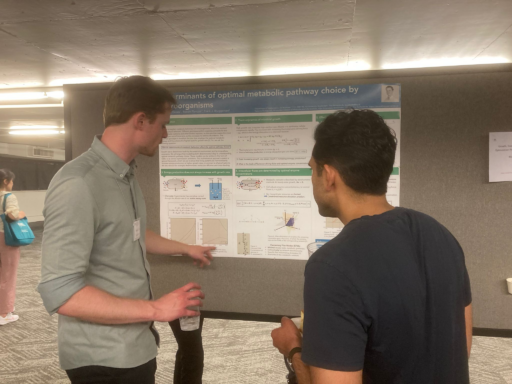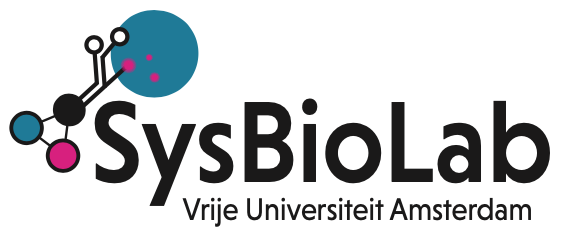PhD candidate Maarten Droste is one of the recipients of the famous Red Sock Award for best poster presentation at the SIAM 2023 Conference on Applications of Dynamical Systems in Portland, Oregon. It is a tradition that each prize winner receives a pair of red socks as part of the award. His winning poster, entitled “Determinants of optimal metabolic pathway choice by microorganisms”, is co-authored by Bob Planqué and Frank Bruggeman.

Maarten’s PhD project is all about understanding the key features and determinants of metabolic pathways choices by microorganisms, using optimality principles and mathematical models.
One of his first results is that physical systems that are alive may obey different principles than those that are inanimate. Whereas inanimate systems generally have increased fluxes (J) at higher thermodynamic driving forces (X) and therefore have a higher entropy production rate (approx. J times X), living systems may adjust their metabolism at higher nutrient concentrations in such a way that the driving force reduces but the flux – which is what matters for cell – still increases, because they swap longer for shorter pathways that only partially degrade the nutrient(s). They do this because enzyme concentration inside cells are bounded and a shorter pathway allows them to have higher enzyme concentration per reaction, and therefore a higher flux. Thus, natural selection of living microbes for growth rate that does not necessarily lead to higher entropy production, as is sometimes stated.
Another one of his findings is that optimal pathway choice depends on the concentrations of nutrients and products of metabolism. And, therefore, on the characteristics of their biotic and abiotic environment.
The abiotic effect is that the nutrient and product concentrations at the cell’s surface matter for the metabolic flux, which are determined by their values at “infinity”, diffusion coefficients, and the rates of cellular metabolism. Since the rates of cellular metabolism contribute to setting those concentrations, metabolic pathway optimization should be done with nutrient and product diffusion incorporated into the nonlinear optimization problem. Maarten has worked out this fundamental problem.
An important biotic effect also plays a role: The concentrations at the cell’s surface are also determined by the activity of other microbial species, and their relative distances, indicating that ecology matters too! Here Maarten has stumbled on a curious finding when the concentration of a product is low enough, a long pathway can have outperform a shorter pathway – even though the long pathway has lower enzyme concentrations per reaction. Whether this happens depends on the kinetics and abundance of nearby microbes feeding on this product. Thus, microbes together shape their “niche”, affecting their optimal pathway choices!
Maarten will be continuing his scientific adventures, wearing his fresh new pair of red sox!

Recent Comments